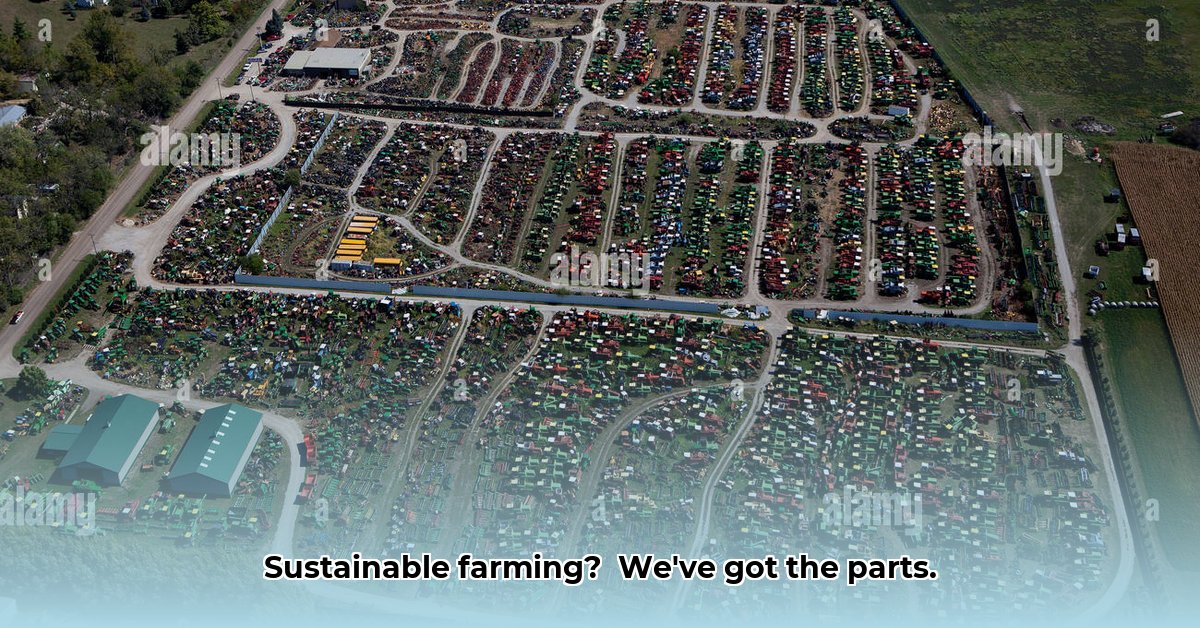
A Case Study of Used Equipment and Sustainable Agriculture
The rising costs of farming and the growing emphasis on environmental sustainability are forcing farmers to re-evaluate their operational strategies. This case study examines Colfax Tractor & Combine Parts, a company specializing in used farm equipment, to analyze the interplay between affordability, equipment lifespan, and environmental impact within the context of sustainable agriculture. The central question is: Does the cost-effectiveness of used equipment truly align with long-term sustainability goals? For more on farm equipment, check out this useful resource.
Colfax's Business Model: A Microcosm of Sustainable Agriculture's Challenges
Colfax Tractor & Combine Parts, operating since 1988, demonstrates a significant market for used agricultural equipment. This indicates a strong preference among farmers for cost-effective solutions. However, this preference raises critical questions regarding the long-term sustainability of this model. While using pre-owned equipment conserves resources in the short-term by reducing the demand for new manufacturing, the challenges of parts acquisition, equipment longevity, and waste management need careful consideration. The prevalent use of used equipment suggests a significant, yet potentially unsustainable, approach toward resource management in agriculture. Does the initial cost savings outweigh the potential for increased repair costs and environmental consequences?
Global Reach, Regional Impact: Analyzing the Carbon Footprint
Colfax's customer base extends beyond the Midwest, suggesting a global demand for affordable equipment. This highlights the potential for knowledge and technology dissemination; however, international shipping significantly increases the carbon footprint. Quantifying the exact CO2 emissions associated with Colfax's operations is crucial for a complete sustainability assessment. The need for a broader data set encompassing various regions and farming practices is apparent. Currently, Colfax's regional focus limits the scope of the analysis. More comprehensive regional and international data on shipping and associated emissions are required before a comprehensive carbon footprint assessment can be completed.
The Double-Edged Sword: Advantages and Disadvantages of Used Equipment
The use of parts salvaged from decommissioned tractors offers cost benefits but presents significant challenges. The uncertainty surrounding the lifespan of these parts, potentially leading to increased downtime and repair costs, directly conflicts with the principles of sustainable farming. A balanced assessment requires careful consideration of both advantages and disadvantages.
Challenges:
- Parts Acquisition: Difficulty sourcing specific parts for older machinery results in extended downtime and reduced operational efficiency. Data on the frequency of part unavailability is needed.
- Equipment Lifespan: The inherent shorter lifespan of used equipment necessitates more frequent and potentially costly repairs, undermining long-term sustainability. Comparative lifespan analysis versus new equipment is urgently needed.
- Environmental Impact: The lack of comprehensive data on waste management practices and emissions related to the entire lifecycle of used equipment (manufacturing, shipping, repairs, end-of-life disposal) hinders a complete environmental assessment. The absence of detailed data on the management of e-waste associated with the dismantling of older tractors makes evaluating the environmental impact challenging.
Opportunities:
- Cost-Effectiveness: Accessibility to farming for individuals with limited capital, promoting inclusivity in food production.
- Resource Conservation: Reducing the demand for new machinery reduces the consumption of resources and energy in the manufacturing process.
- Community Building: Supporting local repair shops strengthens community bonds and preserves traditional repair skills.
Recommendations for Sustainable Practices
A collaborative effort is essential to improve the sustainability of the used equipment market.
| Stakeholder | Short-Term Actions (Within 1 Year) | Long-Term Strategies (3-5 Years) |
|---|---|---|
| Colfax Tractor & Auto Parts | Implement robust parts inventory tracking; Collect detailed data on part lifespan. | Invest in predictive maintenance technology; Develop strategic partnerships with parts suppliers. |
| Farmers | Establish strong relationships with Colfax and local repair shops; prioritize preventative maintenance. | Invest in equipment maintenance training; Explore cooperative models for resource sharing. |
| Sustainable Ag Organizations | Conduct comprehensive life-cycle assessments of used equipment; advocate for policy changes. | Promote farmer education and training programs; advocate for improved waste management regulations. |
| Government Agencies | Provide tax incentives for equipment repair and refurbishment; support research into durable farming technology. | Fund research on sustainable practices; develop robust used equipment parts market frameworks. |
The Crucial Need for Data-Driven Insights
Addressing the sustainability challenges of used equipment requires comprehensive data:
- Parts Availability Data: Detailed information on the frequency of farmers obtaining necessary parts.
- Comparative Lifespan Data: A rigorous comparison of the operational lifespan of used versus new equipment.
- Carbon Footprint Assessment: An accurate evaluation of CO2 emissions through the entire lifecycle of used equipment (manufacturing, shipping, repairs, and disposal).
- Regulatory Compliance Data: A robust evaluation of regulatory compliance within the used equipment industry, encompassing environmental and labor standards.
This analysis of Colfax Tractor & Combine Parts underscores the complexity of achieving sustainable agriculture. By addressing the challenges and capitalizing on the opportunities presented by used equipment, while simultaneously enhancing data collection and fostering collaboration among stakeholders, we can progress towards a more environmentally and economically sustainable agricultural future. Further research is imperative to develop a comprehensive understanding of this complex issue.